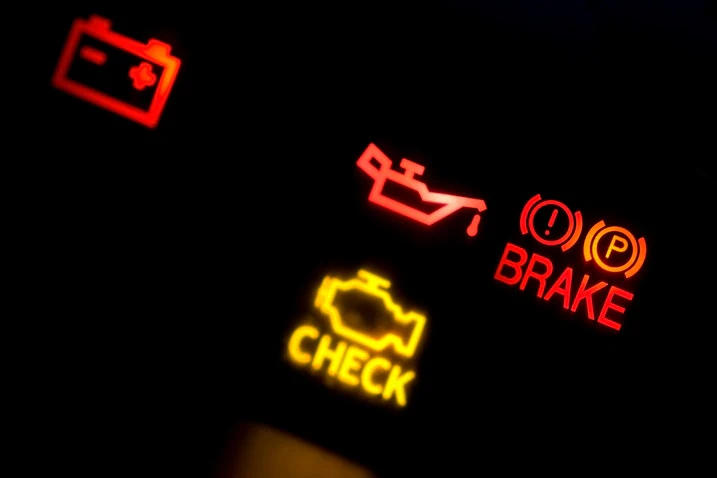Repair instructions
Why Is My Check Engine Light On?
Summary:
- Your check engine light (CEL) turns on when there’s a problem that could increase your vehicle’s tailpipe emissions.
- Issues with sensors, circuits, modules, and data networks can trigger the CEL.
- It’s important to address the issue promptly. Start by retrieving diagnostic trouble codes (DTCs) to help pinpoint the problem.
If you’ve ever been cruising along, enjoying the drive, and then suddenly your check engine light lights up, you know the sinking feeling that comes with it. That little warning light can cause panic, and with good reason: since the 1980s, the CEL has been a sign that something isn’t quite right with your car.
But what exactly does it mean? Is it a major issue, or just a small glitch?
What Does the Check Engine Light Mean?
The check engine light doesn’t always mean there’s something wrong with the engine itself, though that’s one possibility. The CEL can light up for a wide range of reasons, all of which relate to the potential for increased emissions.
Since 1988, the California Air Resources Board (CARB) has required manufacturers to equip vehicles with the CEL to help reduce harmful emissions. Here’s how it works:
Your vehicle’s powertrain control module (PCM), which is essentially the car’s computer, constantly monitors systems that affect emissions. When it detects a fault, the PCM triggers the CEL and stores a diagnostic trouble code (DTC) that can be retrieved with a scan tool.

This code is your first clue, helping you and your technician start troubleshooting the issue.
Why Is My Check Engine Light On?
There isn’t a one-size-fits-all answer. The CEL could be triggered by a range of problems that might increase emissions. Some of the most common culprits include:
1. Sensor Issues:
Your car relies on a network of sensors to monitor its powertrain. If one of these sensors malfunctions, it can trigger the CEL.
2. Circuit Problems:
Modern vehicles have miles of wiring. If there’s an issue with any part of the electrical system—such as faulty wires or blown fuses—especially related to the powertrain, the check engine light will come on.
3. Module and Data Network Problems:
Today’s cars are packed with computers (modules) that communicate over a data network. Any issue with these modules or their communication lines can trigger the CEL.
4. Ignition System Problems:
For your engine to run smoothly, it needs a precise balance of air, fuel, and spark. If the ignition system fails, it can lead to engine misfires and increased emissions—prompting the check engine light.
5. Air/Fuel Mixture Issues:
If the balance of air and fuel in your engine is off, it can cause inefficient combustion, leading to higher emissions and an illuminated CEL.
6. Engine Mechanical Problems:
Loss of engine compression, caused by mechanical issues, can lead to misfires and increased emissions, causing the check engine light to turn on.
7. Variable Valve Timing (VVT) System Problems:
Modern engines use VVT to adjust valve timing for better efficiency. If something goes wrong with this system, the CEL will alert you.
8. Emissions Equipment Issues:
From your catalytic converter to your exhaust gas recirculation (EGR) valve, any failure in your vehicle’s emissions control systems can trigger the check engine light.
9. Automatic Transmission Issues:
Transmission problems can impact engine performance, increasing emissions. The control module for the transmission will turn on the check engine light if it detects an issue.
What Should You Do When the Check Engine Light Comes On?
First and foremost, don’t ignore it. The CEL could indicate a problem that might not only cause further damage but also affect your vehicle’s emissions—meaning you could fail a state emissions test.
Start by checking for diagnostic trouble codes (DTCs) using a scan tool or code reader. These codes won’t tell you exactly what’s wrong, but they’ll point you in the right direction and provide a solid starting point for troubleshooting.
Once you or your technician identifies the issue, repairs can be made. After fixing the problem, the codes can be cleared, and the check engine light should go off. If the light stays off, you’ve successfully addressed the issue.
In Conclusion:
The check engine light is your vehicle’s way of telling you something’s off, and it’s often related to emissions. Whether it’s a sensor, ignition issue, or something else, addressing the problem as soon as possible can prevent further damage and ensure your car is running efficiently. Always use the diagnostic trouble codes as a first step in troubleshooting, and be sure to get the issue repaired promptly to keep your car running smoothly.
